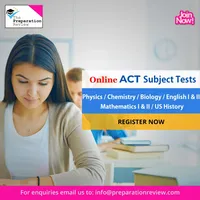
Biology test questions ask students to solve problems and demonstrate understanding of topics including: biochemistry and the cell, genetics and evolution, and animal and plant systems and ecology. Students must demonstrate an understanding of scientific practices by applying knowledge of scientific inquiry and by using mathematics, measurement, and graphical models to solve problems.
Chemistry test questions ask students to solve problems and demonstrate understanding of topics including: states of matter and phase changes, mole concept, chemical formulas, chemical equations, stoichiometry, gas laws, atomic structure, periodicity, chemical bonding, solution properties, Le Chatelier’s principle, basic thermodynamics, and acids and bases. Chemistry test questions ask students to apply proportional reasoning and other mathematical thinking to solve problems.
Physics test questions ask students to solve problems and demonstrate understanding of topics including: forces and motion (e.g., displacement, velocity, acceleration, momentum, force, impulse, Work-Energy theorem, power, work), fundamental forces (e.g., Newton’s law of gravitation, Coulomb’s law, magnetism, Ohm’s law, circuits), and waves and periodic motion (e.g., wave speed, frequency, wavelength, wave types, simple harmonic motion, Doppler effect, optics). Physics test questions ask students to apply proportional reasoning, graphical models, and other mathematical thinking to solve problems.
Students can affirm the algebra and geometry skills typically developed through the first years of secondary school. These skills include solving equations, drawing conclusions from data, finding areas and volumes, and making judgments about proofs. Calculators are encouraged, and a reference sheet provides common formulas.
Students can affirm their advanced algebra and precalculus skills. These skills include understanding complex numbers, modeling with vectors and matrices, applying advanced functions, finding limits, fitting a normal distribution, and interpreting graphs in the polar coordinate plane. Calculators are encouraged, and a reference sheet provides common formulas.
The U.S. History test covers a detailed overview of United States history, from the country’s beginnings to the post–World War II era. Test questions ask student to show knowledge and insight into the forging of the new nation, the sectional conflicts that nearly tore it apart, and the Civil War and Reconstruction. Students need to know about nineteenth-century industrialization and urbanization, the growth of the West and the “New South,” and political efforts to reform capitalism. Students will also analyze the effects of the Great Depression and the New Deal, the Cold War and the United States’ role as a world power, and more recent challenges such as movements for equality, environmental issues, and global terrorism. Students should be able to investigate and interpret past events, and apply knowledge to real-world situations.
English 1 and 2 assess students’ knowledge, skills, and abilities as readers and writers. Questions use a diverse collection of authentic, high-quality texts that have been taught in successful classrooms across the United States, including drama, fiction, nonfiction, and poetry texts, as well as film scripts. The English tests also assess knowledge and skills required to write effectively in high school and college.